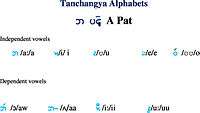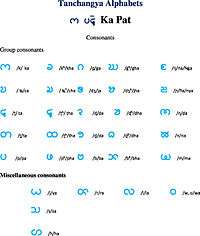Tanchangya alphabet
The Tanchangya alphabet, also known as Ka-Pat, is an abugida used to write the Tanchangya language. It is in the southern Brahmic family of scripts. Due to its script family, it has similarities to the Burmese alphabet, Mon alphabet, and Chakma alphabet.
| Tanchangya | |
|---|---|
| Type | |
Parent systems | Proto-Sinaitic alphabet |
Origin
The Tanchangya alphabets were introduced recently in 2012 by adopting a manuscript in Rakhine State as stated by Rupak Debnath.[1] Though both Chakma and Tanchangya have been using the present Chakma alphabet for a long time, it is still unconfirmed who the alphabets originally belonged to and who introduced it. John M. Clifton in his ‘’Dialects, Orthography and Society ‘’opined that ‘the Tanchangya community decided to base their alphabet on the Chakma to show they were related to the Chakma. However, they systematically changed the alphabet to show that they were different from the Chakma they were not simply a part of the larger Chakma community.’ [2] Moreover, in order not to cause misunderstanding between two communities, Tanchangya has introduced these alphabets which are yet to develop into Unicode font. For the time being, it is just created as True Font.
Writing system
It is written from left to right, similarly to Brahmi scripts, unlike the Kharosti, which were used to write from right to left.

Vowels
There are five independent vowels such as A (a:), I(i), v(ʊ), E(e), and O a(oʊ). The other five vowels are dependent namely, Aa(ɔ) , AA(ʌ), Ii(i:), and Uu(u:).

Consonants
There are thirty-one consonants letter found in Tanchangya alphabets. They are classified into group consonants and miscellaneous consonants.
Arrangement
The alphabets seem to be derived from ancient Brahmic scripts, which inherited the vowel sound within the consonants. If not an independent derivation, it should have derived from Burmese or Mon due to their dwelling with Mon and Burmese from 9th Century B.C (in Tagong the ancient civilisation of Burma [3] to until the 15th century Common Era (during the 15th Century, they were attacked by the Rakhine king and brought them to Arakan in 15th Century from Micchagiri, present Thaye in Magwe Division to Arakan) (Dhanyawady Aye Daw Bung, 4). It is believed that they had used the Brahmi scripts in the earlier stages, who were known by the term Thek or Sakya in northern Myanmar.
Notes
- Rupak-Debnath (2008): 167
- Work Papers of the Summer Institute of Linguistics, (1988).
- Pe Maung Tin & G.H. Luce 2008, p. 1.
References
- Pe Maung Tin; G.H. Luce (2008), The Glass Palace Chronicle of the Kings of Myanmar, Yangon: Unity Publishing House
- Debnath, Rupak (2008), Ethnographic Study of Tanchangya of CHT, CADC, South Tripura and Sittwe, Kolkata: Kreativmind
- Clifton, John M. (2008). "Dialects, Orthography and Society" (PDF). Work Papers of the Summer Institute of Linguistics. Retrieved 2015-11-20.